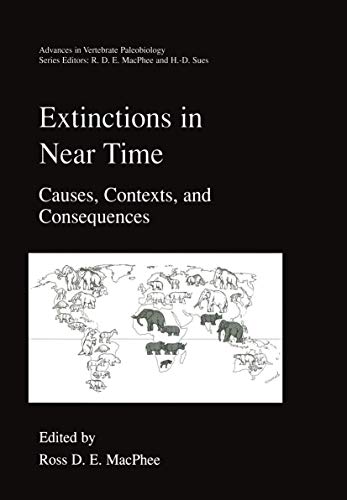Extinctions in Near Time: Causes, Contexts, and Consequences (Advances in Vertebrate Paleobiology, 2) - Hardcover

"synopsis" may belong to another edition of this title.
Discovering Archaeology, 1:5 (1999)
"About this title" may belong to another edition of this title.
- PublisherSpringer
- Publication date1999
- ISBN 10 0306460920
- ISBN 13 9780306460920
- BindingHardcover
- Number of pages411
- EditorMacPhee Ross D.E., Sues Hans-Dieter
Buy New
Learn more about this copy
Shipping:
US$ 52.43
From Germany to U.S.A.
Top Search Results from the AbeBooks Marketplace
Extinctions in Near Time
Book Description Gebunden. Condition: New. Seller Inventory # 5902919
Extinctions in Near Time
Book Description Buch. Condition: Neu. This item is printed on demand - it takes 3-4 days longer - Neuware -'Near time' -an interval that spans the last 100,000 years or so of earth history-qualifies as a remarkable period for many reasons. From an anthropocentric point of view, the out standing feature of near time is the fact that the evolution, cultural diversification, and glob al spread of Homo sapiens have all occurred within it. From a wider biological perspective, however, the hallmark of near time is better conceived of as being one of enduring, repeat ed loss. The point is important. Despite the sense of uniqueness implicit in phrases like 'the biodiversity crisis,' meant to convey the notion that the present bout of extinctions is by far the worst endured in recent times, substantial losses have occurred throughout near time. In the majority of cases, these losses occurred when, and only when, people began to ex pand across areas that had never before experienced their presence. Although the explana tion for these correlations in time and space may seem obvious, it is one thing to rhetori cally observe that there is a connection between humans and recent extinctions, and quite another to demonstrate it scientifically. How should this be done Traditionally, the study of past extinctions has fallen largely to researchers steeped in such disciplines as paleontology, systematics, and paleoecology. The evaluation of future losses, by contrast, has lain almost exclusively within the domain of conservation biolo gists. Now, more than ever, there is opportunity for overlap and sharing of information. 420 pp. Englisch. Seller Inventory # 9780306460920
Extinctions in Near Time : Causes, Contexts, and Consequences
Book Description Buch. Condition: Neu. Druck auf Anfrage Neuware - Printed after ordering - 'Near time' -an interval that spans the last 100,000 years or so of earth history-qualifies as a remarkable period for many reasons. From an anthropocentric point of view, the out standing feature of near time is the fact that the evolution, cultural diversification, and glob al spread of Homo sapiens have all occurred within it. From a wider biological perspective, however, the hallmark of near time is better conceived of as being one of enduring, repeat ed loss. The point is important. Despite the sense of uniqueness implicit in phrases like 'the biodiversity crisis,' meant to convey the notion that the present bout of extinctions is by far the worst endured in recent times, substantial losses have occurred throughout near time. In the majority of cases, these losses occurred when, and only when, people began to ex pand across areas that had never before experienced their presence. Although the explana tion for these correlations in time and space may seem obvious, it is one thing to rhetori cally observe that there is a connection between humans and recent extinctions, and quite another to demonstrate it scientifically. How should this be done Traditionally, the study of past extinctions has fallen largely to researchers steeped in such disciplines as paleontology, systematics, and paleoecology. The evaluation of future losses, by contrast, has lain almost exclusively within the domain of conservation biolo gists. Now, more than ever, there is opportunity for overlap and sharing of information. Seller Inventory # 9780306460920

